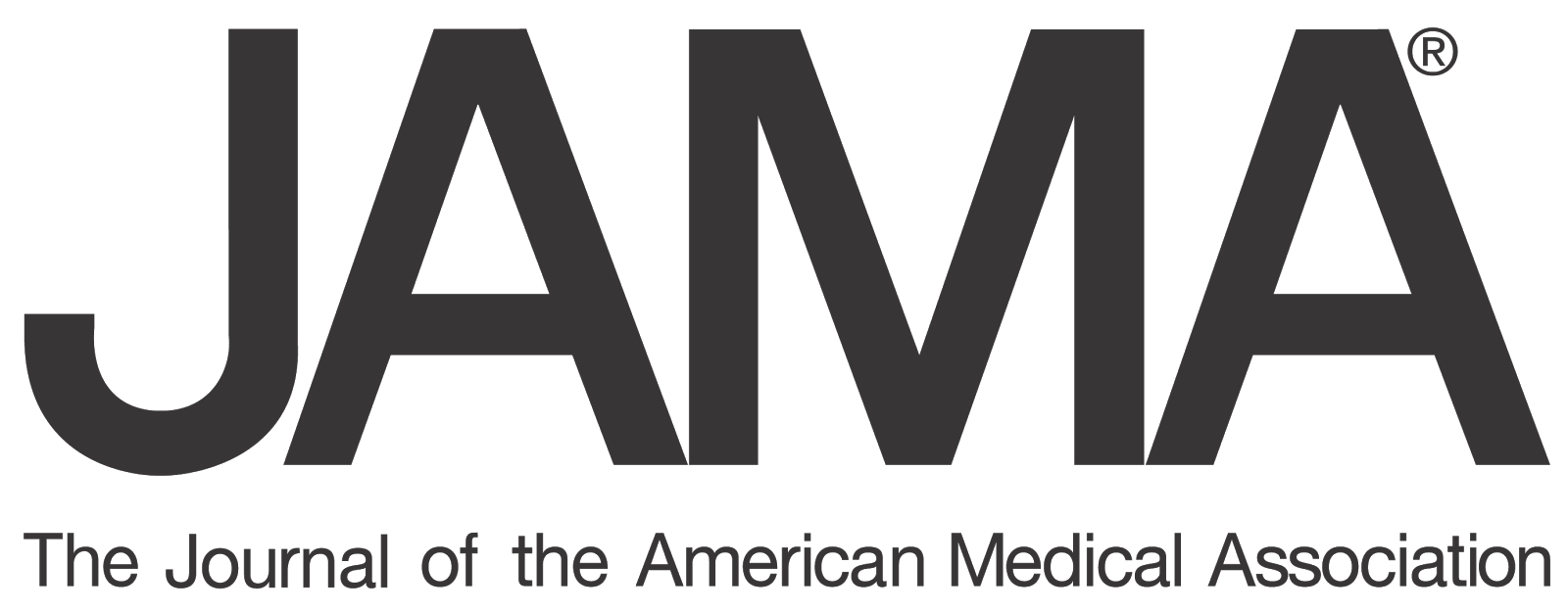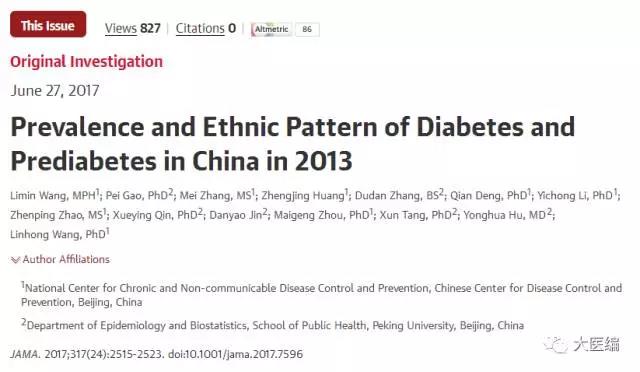号外:JAMA公布最新中国糖尿病流行病数据
国际知名的医学杂志之一《美国医学会杂志》(The Journal of theAmerican Medical Association,JAMA)在2017年6月刊登了标题为“Prevalenceand Ethnic Pattern of Diabetes and Prediabetes in China in 2013(2013年中国糖尿病和前期糖尿病的患病率和种族格局)”的研究文章。

在该篇研究文章中,报道了2013年中国糖尿病和前期糖尿病的一些情况,下面我们从以下几个方面为大家简要介绍该项研究。

1. Key Points
Question What is the prevalence ofdiabetes and prediabetes in China?
Findings In this nationallyrepresentative cross-sectional survey conducted in 2013 in mainland China with170287 participants, the estimated overallprevalence of total diabetes was 10.9%; of prediabetes, 35.7%. Tibetan andMuslim Chinese individuals had significantly lower prevalence of diabetes thanHan participants.
Meaning The estimated prevalence ofdiabetes and prediabetes in China differs by ethnic group, and the estimatedoverall high prevalence may be associated with different methods of measuringhemoglobin A1c.
问题:中国糖尿病和前期糖尿病的患病率如何?
研究结果:有170287人参加的2013年在中国大陆进行的全国代表性的横断面研究中,总体糖尿病患病率的估计值为10.9%,前期糖尿病为35.7%。其中,藏族和回族的糖尿病患病率明显降低于汉族。
研究意义:中国糖尿病和前期糖尿病的患病率因种族不同而不同,并且估计的总体高发率可能与不同的测量血红蛋白A1c的方法有关。
2. Introduction
China has theworld’s largest diabetes epidemic, which continues to increase. The prevalenceof diabetes in China was reported to be 0.67% in 1980 and 11.6% in the latestpublished nationwide estimate in 2010. Moreover, according to the 2010 survey,the prevalence of prediabetes was 50.1%, implying that approximately 500million Chinese adults may have had prediabetes. However, this high estimatefor prediabetes raised concern over the possibility of an overestimation. As adisorder of glucose metabolism, diabetes mellitus affects multiple organsystems and is associated with a variety of vascular and several nonvascularcomplications. Ongoing reliable estimations are needed to plan effectivenational prevention and treatment programs for diabetes management.
In addition,although a few epidemiologic studies were available to estimate the prevalenceof diabetes among different ethnic groups in China, the data were fromdifferent studies conducted at different times. Direct comparison under aconsistent survey design is therefore of importance for policy making fordiabetes management in Chinese minorities.
This study wasconducted to provide more recent estimates of the prevalence of diabetes andprediabetes in China and to investigate their ethnic pattern, using anationally representative survey conducted in 2013.
中国是世界上最大的糖尿病流行病国,并且不断增加。1980年中国糖尿病患病率报告为百0.67%,2010年度最新公布的全国性的估计的患病率为11.6%。此外,根据2010年的调查,前期糖尿病患病率为50.1%,这意味着约有5亿中国人可能患有前期糖尿病。然而,对前期糖尿病的这个高估引起了对过高估计的可能性的担忧。由于葡萄糖代谢紊乱,糖尿病影响多器官系统,并与多种血管和几种非血管并发症有关。因此需要进行持续的可靠的估计,以制定有效的国家糖尿病管理预防和治疗计划。
另外,尽管有几项流行病学研究可用于估算中国不同民族患病率,但数据来自不同时期进行的不同研究。因此,在一致的调查设计下进行直接比较对于中国少数民族糖尿病管理政策的制定具有重要意义
本研究旨在应用2013年进行的全国代表调查提供更近期的中国糖尿病和前期糖尿病的患病率的估算值并且研究其种族特征。
3. Abstract
Importance Previousstudies have shown increasing prevalence of diabetes in China, which now hasthe world’s largest diabetes epidemic.
Objectives To estimatethe recent prevalence and to investigate the ethnic variation of diabetes andprediabetes in the Chinese adult population.
Design, Setting, and Participants Anationally representative cross-sectional survey in 2013 in mainland China,which consisted of 170287 participants.
Exposures Fasting plasma glucose andhemoglobin A1c levels were measured for all participants. A 2-hour oral glucosetolerance test was conducted for all participants without diagnosed diabetes.
Main Outcomes and Measures Primaryoutcomes were total diabetes and prediabetes defined according to the 2010American Diabetes Association criteria. Awareness and treatment were alsoevaluated. Hemoglobin A1c concentration of less than 7.0% among treateddiabetes patients was considered adequate glycemic control. Minority ethnicgroups in China with at least 1000 participants (Tibetan, Zhuang, Manchu,Uyghur, and Muslim) were compared with Han participants.
Results Among the Chinese adultpopulation, the estimated standardized prevalence of total diagnosed andundiagnosed diabetes was 10.9% (95% CI, 10.4%-11.5%); that of diagnoseddiabetes, 4.0% (95% CI, 3.6%-4.3%); and that of prediabetes, 35.7% (95% CI,34.1%-37.4%). Among persons with diabetes, 36.5% (95% CI, 34.3%-38.6%) wereaware of their diagnosis and 32.2% (95% CI, 30.1%-34.2%) were treated; 49.2%(95% CI, 46.9%-51.5%) of patients treated had adequate glycemic control.Tibetan and Muslim Chinese had significantly lower crude prevalence of diabetesthan Han participants (14.7% [95% CI, 14.6%-14.9%] for Han, 4.3% [95% CI,3.5%-5.0%] for Tibetan, and 10.6% [95% CI, 9.3%-11.9%] for Muslim; P<.001 for Tibetan and Muslim compared withHan). In the multivariable logistic models, the adjusted odds ratios comparedwith Han participants were 0.42 (95% CI, 0.35-0.50) for diabetes and 0.77 (95%CI, 0.71-0.84) for prediabetes for Tibetan Chinese and 0.73 (95% CI, 0.63-0.85)for diabetes and 0.78 (95% CI, 0.71-0.86) for prediabetes in Muslim Chinese.
Conclusions and Relevance Among adultsin China, the estimated overall prevalence of diabetes was 10.9%, and that forprediabetes was 35.7%. Differences from previous estimates for 2010 may be dueto an alternate method of measuring hemoglobin A1c.
重要性:此前的研究显示,中国糖尿病患病率不断上升,目前已成为世界上最大的糖尿病流行国
研究目标:估计最近的患病率,并调查中国成年人群体中糖尿病和前期糖尿病的种族间差异。
实验的设计,设置和参与者:2013年在中国大陆进行的全国性代表性横断面调查,其中共有170287人参加。
暴露:测量所有参与者的空腹血浆葡萄糖和血红蛋白A1c水平。 对所有没有诊断为糖尿病的患者进行2小时口服葡萄糖耐受量测试。
主要结果与实验方法:本研究是采用2010年美国糖尿病协会诊断标准。 另外还评估了认知和治疗。 接受治疗的糖尿病患者的血红蛋白A1c浓度小于7.0%被认为是具有足够的血糖控制。至少有1000人(西藏,壮族,满族,维吾尔和穆斯林)的中国少数民族群体用来与汉族参与者比较。
实验结果:在中国成年人群中,诊断和未诊断的总糖尿病的患病率为10.9%(95%CI,10.4%-11.5%);其中诊断的糖尿病的估计标准化患病率为4.0%(95%CI,3.6%-4.3%);前期糖尿病为35.7%(95%CI,34.1%-37.4%)。在糖尿病患者中,36.5%(95%CI,34.3%-38.6%)认知到对其的诊断,32.2%(95%CI,30.1%-34.2%)得到治疗; 在接受治疗的患者中,49.2%(95%CI,46.9%-51.5%)接受治疗的患者获得了足够的血糖控制。
藏族人和回族人的糖尿病患病率明显低于汉族人(汉族人14.7%[95% CI, 14.6%-14.9%],藏族人4.3%[95% CI, 3.5%-5.0%],回族人10.6%[95% CI, 9.3%-11.9%];藏族人和回族人与汉族相比的P <.001)。
在多变量逻辑模型中,与汉族参与者相比,调整后的优势比分别为:对于藏族人,糖尿病为0.42 (95% CI, 0.35-0.50)、前期糖尿病为0.77 (95% CI,0.71-0.84);对于回族人,糖尿病为0.73 (95% CI, 0.63-0.85)、前期糖尿病为0.78 (95% CI, 0.71-0.86)。
结论和相关性
在中国的成年人中,总的糖尿病患病率为10.9%,前期糖尿病为35.7%。 与之前的2010年的估计值的差异是由于用了一种替代方法测量血红蛋白A1c。
(如需该研究论文原文请和本园地专家联系)
(文/作者:糖醋咖喱;来源:大医编微信公众号和JAMA官方网站)
糖醋咖喱简介:
Dr. Salt,苏州医学院(原中国核工业总公司放射医学研究所)放射医学/放射卫生硕士、复旦大学影像与核医学博士、上海交通大学临床医学肿瘤影像/消化博士后、美国约翰霍普金斯大学卫生政策与管理博士后。
热门文章
版权声明:本平台所有注明“原创”的作品,版权归“医牛”所有,未经书面授权,任何媒体、网站和个人禁止进行转载、摘编、复制等任何使用,未经授权使用将承担相应法律责任。授权转载时须注明“来源; 医牛健康资讯网”。本平台所有转载文章系出于传递更多信息之目的,且明确注明来源和作者,不希望被转载的媒体或个人可与我们联系,我们将立即进行删除处理。图片均来自于网络,版权属于原作者。
